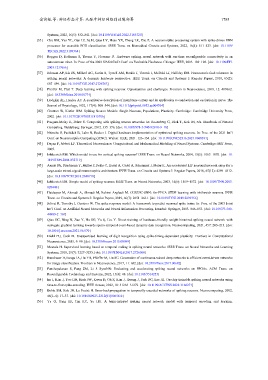Page 379 - 《软件学报》2025年第4期
P. 379
俞诗航 等: 神经形态计算: 从脉冲神经网络到边缘部署 1785
Systems, 2022, 16(5): 832–841. [doi: 10.1109/TBCAS.2022.3185720]
[35] Chu HM, Yan YL, Gan LJ, Jia H, Qian LY, Huan YX, Zheng LR, Zou Z. A neuromorphic processing system with spike-driven SNN
processor for wearable ECG classification. IEEE Trans. on Biomedical Circuits and Systems, 2022, 16(4): 511–523. [doi: 10.1109/
TBCAS.2022.3189364]
[36] Roggen D, Hofmann S, Thoma Y, Floreano D. Hardware spiking neural network with run-time reconfigurable connectivity in an
autonomous robot. In: Proc. of the 2003 NASA/DoD Conf. on Evolvable Hardware. Chicago: IEEE, 2003. 189–198. [doi: 10.1109/EH.
2003.1217666]
[37] Johnson AP, Liu JX, Millard AG, Karim S, Tyrrell AM, Harkin J, Timmis J, McDaid LJ, Halliday DM. Homeostatic fault tolerance in
spiking neural networks: A dynamic hardware perspective. IEEE Trans. on Circuits and Systems I: Regular Papers, 2018, 65(2):
687–699. [doi: 10.1109/TCSI.2017.2726763]
[38] Pfeiffer M, Pfeil T. Deep learning with spiking neurons: Opportunities and challenges. Frontiers in Neuroscience, 2018, 12: 409662.
[doi: 10.3389/fnins.2018.00774]
[39] Hodgkin AL, Huxley AF. A quantitative description of membrane current and its application to conduction and excitation in nerve. The
Journal of Physiology, 1952, 117(4): 500–544. [doi: 10.1113/jphysiol.1952.sp004764]
[40] Gerstner W, Kistler WM. Spiking Neuron Models: Single Neurons, Populations, Plasticity. Cambridge: Cambridge University Press,
2002. [doi: 10.1017/CBO9780511815706]
[41] Paugam-Moisy H, Bohte S. Computing with spiking neuron networks. In: Rozenberg G, Bäck T, Kok JN, eds. Handbook of Natural
Computing. Heidelberg: Springer, 2012. 335–376. [doi: 10.1007/978-3-540-92910-9_10]
[42] Nitzsche S, Pachideh B, Luhn N, Becker J. Digital hardware implementation of optimized spiking neurons. In: Proc. of the 2021 Int’l
Conf. on Neuromorphic Computing (ICNC). Wuhan: IEEE, 2021. 126–134. [doi: 10.1109/ICNC52316.2021.9608391]
[43] Dayan P, Abbott LF. Theoretical Neuroscience: Computational and Mathematical Modeling of Neural Systems. Cambridge: MIT Press,
2005.
[44] Izhikevich EM. Which model to use for cortical spiking neurons? IEEE Trans. on Neural Networks, 2004, 15(5): 1063–1070. [doi: 10.
1109/TNN.2004.832719]
[45] Aamir SA, Stradmann Y, Müller P, Pehle C, Hartel A, Grubl A, Schemmel J, Meier K. An accelerated LIF neuronal network array for a
large-scale mixed-signal neuromorphic architecture. IEEE Trans. on Circuits and Systems I: Regular Papers, 2018, 65(12): 4299–4312.
[doi: 10.1109/TCSI.2018.2840718]
[46] Systems, 2018, 29(7): 3227–3235. [doi: 10.1109/TNNLS.2017.2726060]
Izhikevich EM. Simple model of spiking neurons. IEEE Trans. on Neural Networks, 2003, 14(6): 1569–1572. [doi: 10.1109/TNN.2003.
820440]
[47] Heidarpur M, Ahmadi A, Ahmadi M, Rahimi Azghadi M. CORDIC-SNN: On-FPGA STDP learning with izhikevich neurons. IEEE
Trans. on Circuits and Systems I: Regular Papers, 2019, 66(7): 2651–2661. [doi: 10.1109/TCSI.2019.2899356]
[48] Jolivet R, Timothy J, Gerstner W. The spike response model: A framework to predict neuronal spike trains. In: Proc. of the 2003 Joint
Int’l Conf. on Artificial Neural Networks and Neural Information Processing. Istanbul: Springer, 2003. 846–853. [doi: 10.1007/3-540-
44989-2_101]
[49] Qiao GC, Ning N, Zuo Y, Hu SG, Yu Q, Liu Y. Direct training of hardware-friendly weight binarized spiking neural network with
surrogate gradient learning towards spatio-temporal event-based dynamic data recognition. Neurocomputing, 2021, 457: 203–213. [doi:
10.1016/j.neucom.2021.06.070]
[50] Diehl PU, Cook M. Unsupervised learning of digit recognition using spike-timing-dependent plasticity. Frontiers in Computational
Neuroscience, 2015, 9: 99. [doi: 10.3389/fncom.2015.00099]
[51] Mostafa H. Supervised learning based on temporal coding in spiking neural networks. IEEE Trans. on Neural Networks and Learning
[52] Rueckauer B, Lungu IA, Hu YH, Pfeiffer M, Liu SC. Conversion of continuous-valued deep networks to efficient event-driven networks
for image classification. Frontiers in Neuroscience, 2017, 11: 682. [doi: 10.3389/fnins.2017.00682]
[53] Panchapakesan S, Fang ZM, Li J. SyncNN: Evaluating and accelerating spiking neural networks on FPGAs. ACM Trans. on
Reconfigurable Technology and Systems, 2022, 15(4): 48. [doi: 10.1145/3514253]
[54] Im J, Kim J, Yoo HN, Baek JW, Kwon D, Oh S, Kim J, Hwang J, Park BG, Lee JH. On-chip trainable spiking neural networks using
time-to-first-spike encoding. IEEE Access, 2022, 10: 31263–31272. [doi: 10.1109/ACCESS.2022.3160271]
[55] Bohte SM, Kok JN, La Poutré H. Error-backpropagation in temporally encoded networks of spiking neurons. Neurocomputing, 2002,
48(1–4): 17–37. [doi: 10.1016/S0925-2312(01)00658-0]
[56] Yu Q, Tang HJ, Tan KC, Yu HY. A brain-inspired spiking neural network model with temporal encoding and learning.

